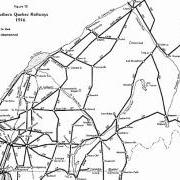 The 19th century saw a massive railway boom all across the Eastern Townships. Driven by the need to access raw materials, the desire for rapid transit, and a mania to build more and more branch lines, companies vied for territory and markets. By 1900, a network of local and regional railway lines crisscrossed virtually every corner of the region. The Grand Trunk (later Canadian National), the Quebec Central, and Canadian Pacific railways emerged as the dominant players.
The 19th century saw a massive railway boom all across the Eastern Townships. Driven by the need to access raw materials, the desire for rapid transit, and a mania to build more and more branch lines, companies vied for territory and markets. By 1900, a network of local and regional railway lines crisscrossed virtually every corner of the region. The Grand Trunk (later Canadian National), the Quebec Central, and Canadian Pacific railways emerged as the dominant players.
The presence of a railway line was a major advantage to a small town. In fact, the good fortune of one town could mean the decline of another. Towns with an early advantage were those situated along the route of the Grand Trunk Railway. This line, completed in 1853, linked Montreal and Portland, Maine, and was the first international railway line in the world. Sherbrooke, Richmond, and Acton Vale, were all situated along the route, and enjoyed rapid growth as a result.
The heyday of the train, however, was relatively short-lived. With the gradual decline of the railways and the closure of many branch lines and stations in the 20th century, some smaller towns and hamlets have reverted to insignificance.